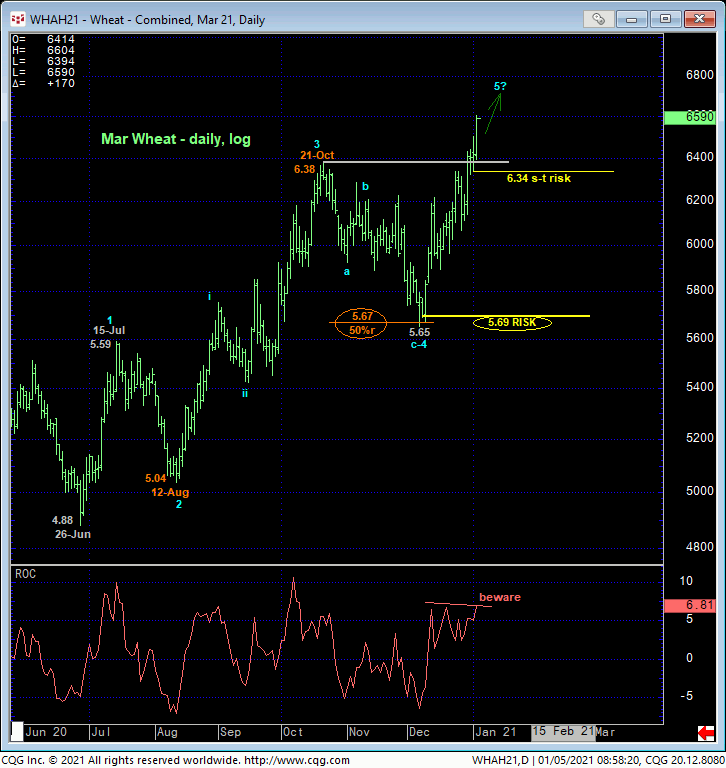
There’s not anyone involved in the grain markets today who’s not wondering two things:
- how high will prices continue to be driven up and
- when do I need to start thinking about a top and reversal and taking profits and/or hedging the downside?
We’re going to attempt to address these questions for the entire grain complex below. But first, we’d like to discuss a few tactical issues that needs to be understand, acknowledged and deployed.
The simple and pretty much only answer to the first question is, there’s no way to know. That’s because the proverbial “trend is your friend” and it will remain intact until a confirmed bearish divergence in momentum stems it. Over the past months we’ve seen a ton of markets that all serve as poster children for ignoring all references to a market being “overbought”. “Overbought” and “oversold” are outside the bounds of technical discipline and are never, ever applicable in the business of markets in any way other than a mocking or satirical way.
The most effective and objective way to navigate a trend turn or even a corrective interruption is via the MOMENTUM indicators. We define a confirmed bearish (in this case) divergence in momentum by either a 1) failure below a prior corrective low or 2) a relapse below an initial counter-trend low. Either occurrence will 1) confirm at least the short-term trend as down and, 2) MOST IMPORTANTLY, reject/define reliable, market-defined highs and resistance from which non-bullish decisions can only then be objectively based and managed. If we’re going to make non-bullish decisions like long-covers in corn, for instance, then we need to be able to identify a specific and objective risk level where that decision is wrong. This can ONLY be done following a confirmed bearish divergence in momentum.
Another key technical and tactical issue is SCALE. Traders and analysts CANNOT conclude longer-term events from shorter-term events. We can not conclude a major top in corn from a mere bearish divergence in hourly momentum. Given the magnitude and uninterrupted nature of virtually all of grain complex markets however, we can identify admittedly very short-term risk parameters that will objectively allow shorter-term traders to take profits and stand aside to avoid the depths unknown of a more protracted correction AND for long-term players to exchange acknowledged whipsaw risk (back above whatever high is left in the wake of a short-term mo failure) for deeper nominal risk on a portion of their position.
In the section below, we identify admittedly extraordinarily tight but objective risk parameters around such shorter-term defensive decisions can be objectively based in corn, beans, meal, bean oil and wheat.
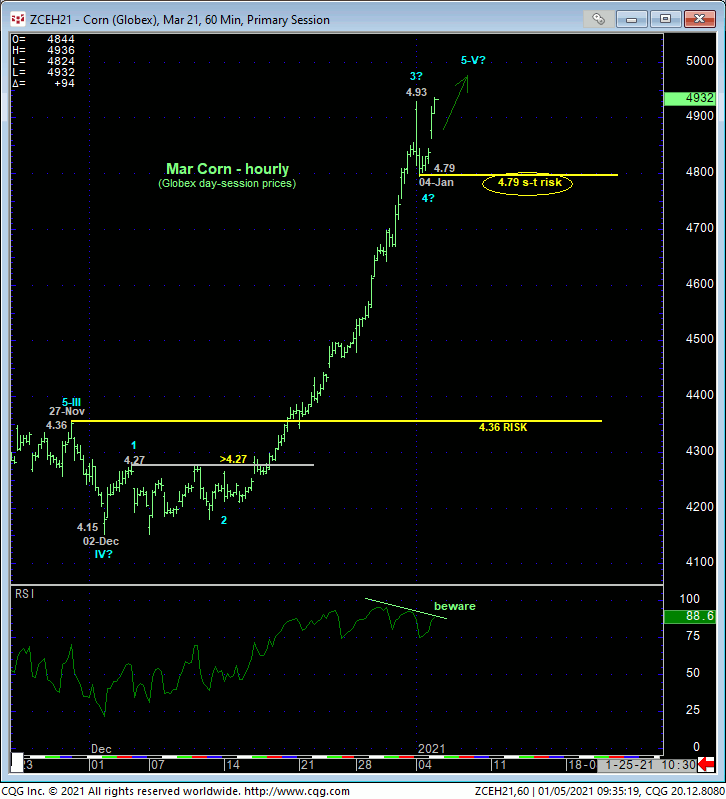
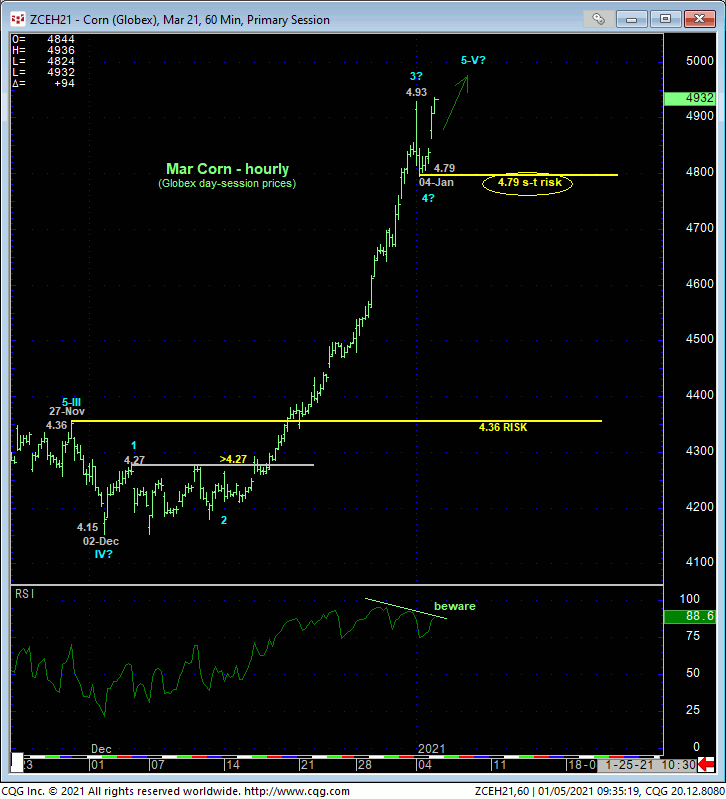
As a result of today’s resumed bull above yesterday’s 4.93 Globex day-session high, the hourly chart above shows that the market has identified yesterday’s 4.79 low as the latest smaller-degree corrective low on an exceptionally short-term scale the market now is minimally required to fail below to confirm a bearish divergence in short-term momentum and define at least an interim high. Per such, we’re defining this level as our new short-term risk parameter from which shorter-term traders can rebase and manage the risk of still-advised bullish policy.
OF COURSE, we would not be able to conclude anything more than an interim corrective hiccup within the secular bull trend following such a sub-4.79 failure, but the extent and uninterrupted nature of the second-half of Dec’s monster rally leaves NO levels of any technical merit below 4.79 shy of 27-Nov’s 4.36 former resistance-turned-support. In effect, 1) there’s no way to know the correction’s downside potential below 4.79 or 2) that such a sub-4.79 failure isn’t the start of a major top. We acknowledge and accept whipsaw risk (back above whatever high would be left in the wake of such a sub-4.79 failure) in exchange for deeper nominal risk.
In sum, a bullish policy and exposure remain advised with a failure below 4.79 required for shorter-term traders to take profits and step aside and for longer-term players to pare exposure to more conservative levels on a failure below 4.79. In lieu of at least such sub-4.79 weakness, the trend remains up on all scales and should not surprise by its continuance or acceleration.
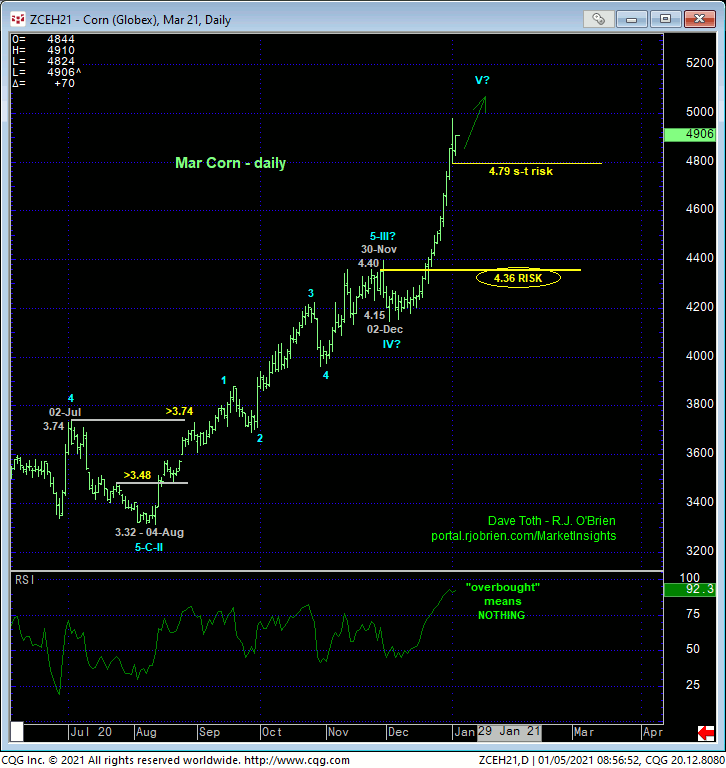
MAR SOYBEANS
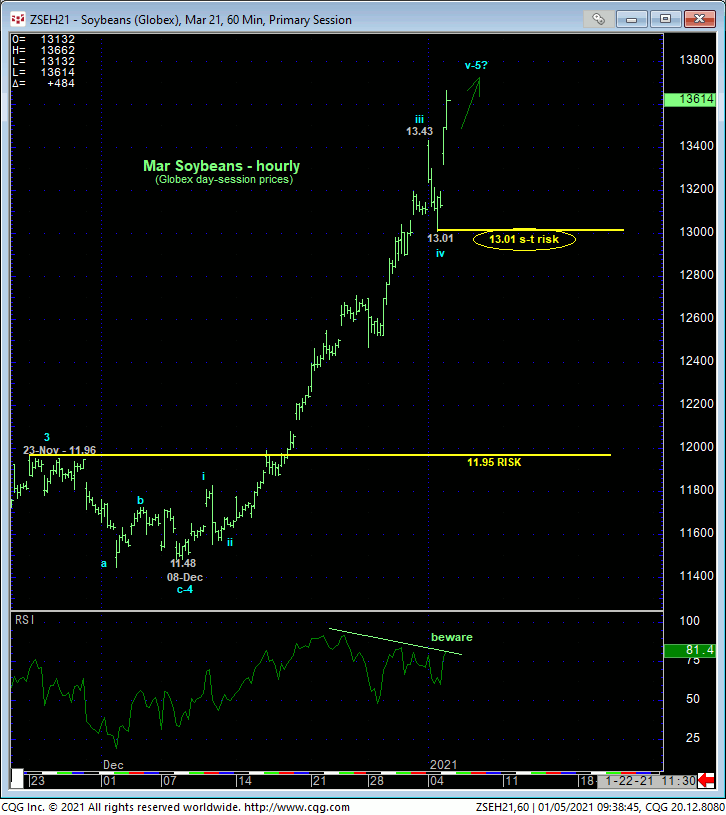
The general approach and technical construct discussed in the corn market above applies to beans as well, with today’s resumption of the secular bull leaving yesterday’s 13.01 low in its wake as the latest smaller-degree corrective low and new short-term risk parameter from which traders can objectively rebase and manage the risk of a still-advised bullish policy and exposure commensurate with their personal risk profiles. A bullish policy and exposure remain advised with a failure below at least 13.01 required to take defensive measures.
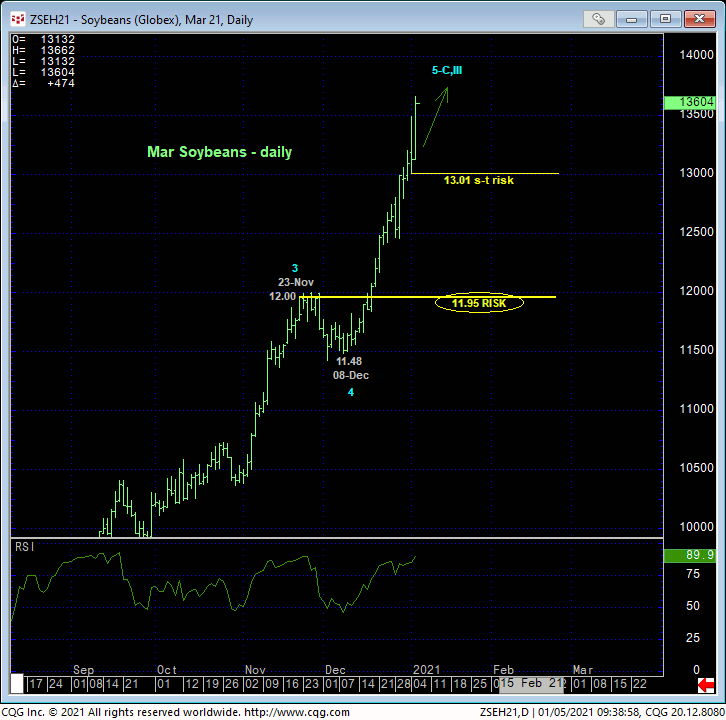
MAR SOYBEAN MEAL
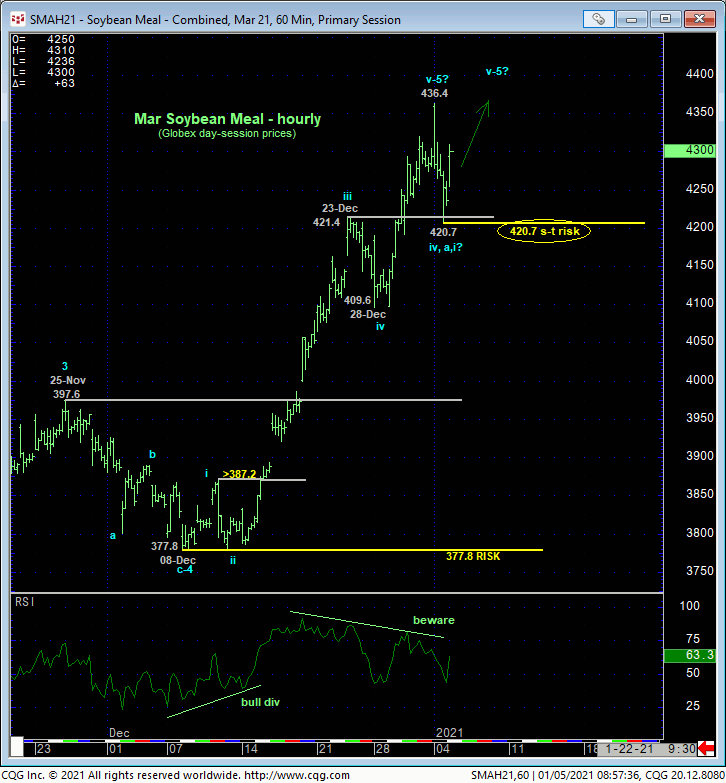
Similarly, a failure below yesterday’s 420.7 low and area of former resistance-turned-support is required to define that level as an initial counter-trend low needed to confirm a bearish divergence in momentum and expose at least an interim correction lower. Per such, this 420.7 is considered our new short-term risk parameter to a still-advised bullish policy and exposure.
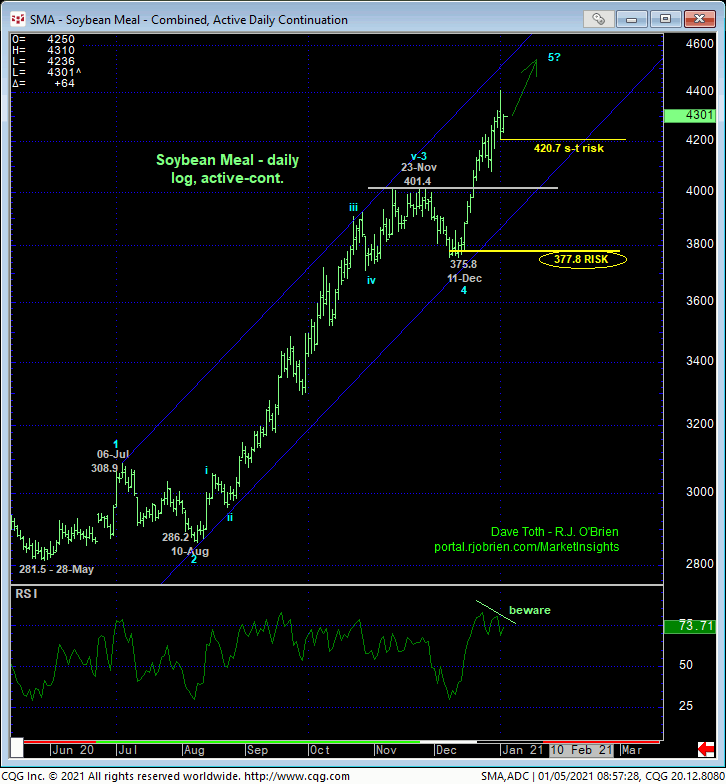
MAR SOYBEAN OIL
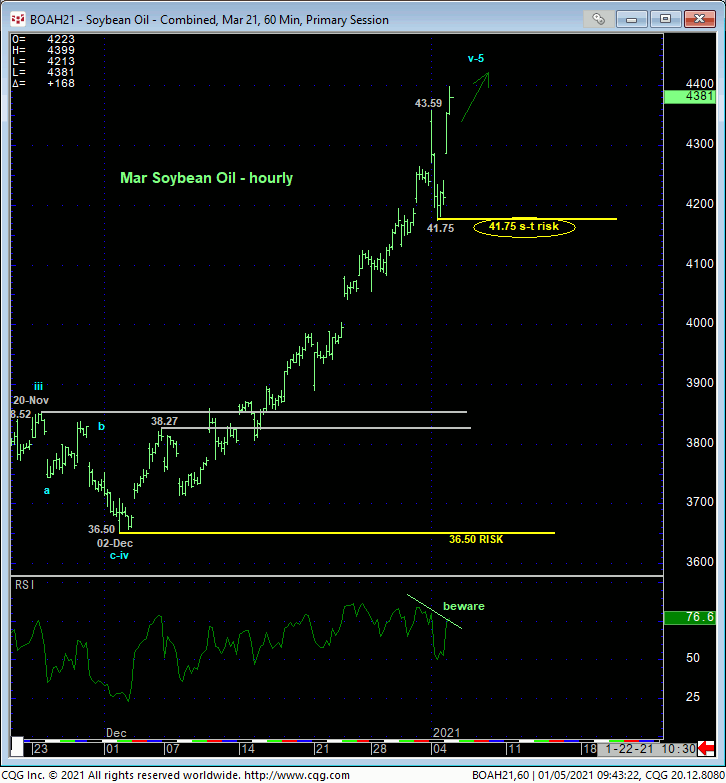
Today’s latest round of new highs in oil leaves yesterday’s 41.75 low as the latest smaller-degree corrective low and tightest risk parameter this market is minimally required to fail below to even defer, let alone threaten the bull. Per such, a full and aggressive bullish policy remains advised with a failure below 541.75 required to defer or threaten this call enough for shorter-term traders to take profits and step aside and for even longer-term commercial players to pare exposure to more conservative levels. In lieu of such sub-41.75 weakness, the trend remains up on all scale and should not surprise by its continuance.
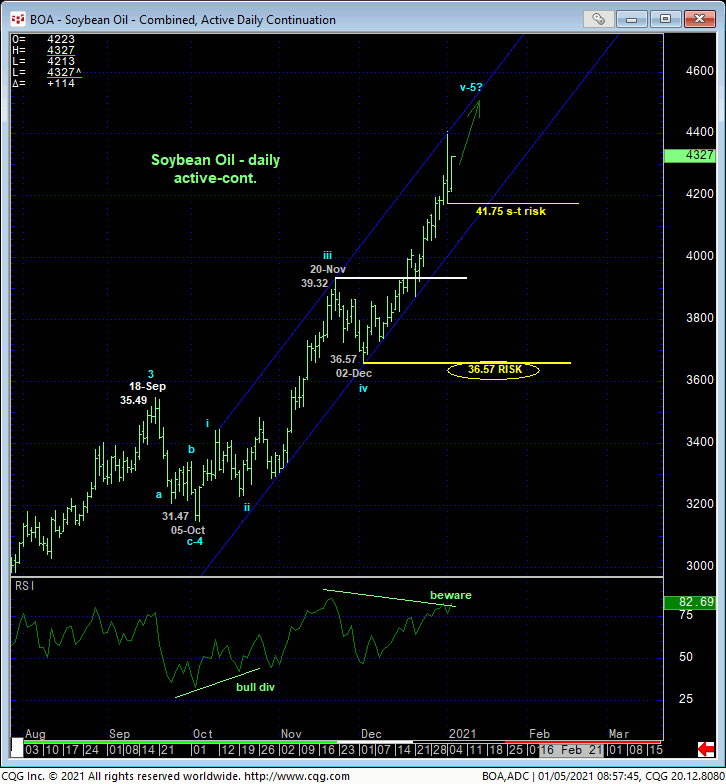
MAR WHEAT
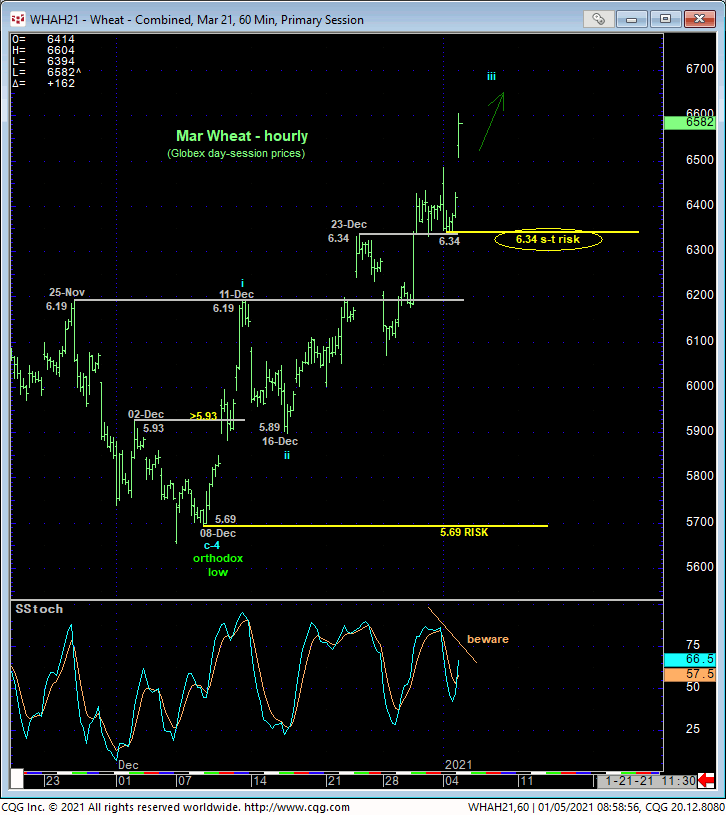
Likewise with wheat and as a direct result of today’s continued gains, the hourly chart above shows that the market has identified yesterday’s 6.34 low as the latest smaller-degree corrective low it is minimally required to fail bellow to confirm a bearish divergence in short-term mo, stem the bull and expose an interim correction lower. Until and unless such sub-6.34 weakness is proven, the trend is up on all scales and should hardly surprise by its continuance or acceleration. In sum, a bullish policy and exposure remain advised with a failure below 6.34 required for shorter-term traders to take profits and for longer-term players to pare exposure to more conservative levels and exchange some whipsaw risk on a portion of their position for larger nominal risk.
